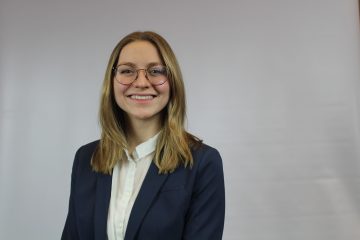Written by: Helena Sverak, PhD Student, Strynadka Lab
Supervisor: Dr. Natalie Strynadka
Course/Workshop: Macromolecular and Cellular Electron Microscopy, January-March 2022
Location/Format: Birkbeck University, London, England. Six virtual discussion and workshop modules along with online lecture materials.
Presenters: Helen Saibil and Elena Orlova

The Strynadka group is interested in the bacterial mechanisms which lead to broad-spectrum antibiotic resistance, with structural and functional characterization of proteins involved in these processes. The goal of our work is to aid in the design of inhibitors of these antimicrobial resistant mechanisms and contribute to the development of novel antibiotics. Traditionally, structural determination of proteins has usually been left to x-ray crystallography, a technique reliant on creation of ultrapure and stable protein crystals. However, recent advancements in hardware and software have allowed for a revolution in cryogenic electron microscopy (Cryo-EM), a much more dynamic imaging technique that captures proteins frozen in solution on microscopic grids. This technique relies on a completely different principle, using electrons to image hundreds of thousands of different orientations of a particular protein. This allows for the reconstruction of a 3D protein model in increasingly comparable resolution to x-ray crystallography. In our lab, we often work on membrane proteins, which represent over a third of all proteins in most organisms and over 50% of drug targets. Despite their biological importance, less than 2% of the PDB of structures are of transmembrane proteins, due to the challenges of working with these samples (Almeida et al, 2017). Cryo-EM gives us a chance to determine the structure of some of these challenging proteins, including a transmembrane transporter that is one of the focuses of my PhD project.
As a first-year student in our lab, I knew that a deep understanding of this technique would be an important aspect of making advancements on my project. Our department of biochemistry is fortunate to have a dedicated High Resolution Macromolecular Cryo-Electron Microscopy facility of our own, but the opportunity came up last winter for a university tutorial course through Birkbeck University in London, England for Macromolecular and Cellular Electron Microscopy. This course was taught by Helen Saibil and Elena Orlova, two professors who have pioneered the creation of this technique and have written some of the foundational literature on recent advances in Cryo-EM. However, due to the state of the pandemic, the course was only offered virtually, which allowed me to still participate in the circumstances.
The course covered all the fundamental aspects of the theory behind electron microscopy, sample preparation, image processing, single particle analysis, electron tomography, and data validation and interpretation. I participated in 6 modules of interactive tutorials and discussions on the subject over three months and took the class with students from a variety of international facilities. Being put in such a collaborative learning environment was incredibly helpful in my first year in structural biochemistry. Because I started my graduate studies during COVID, networking opportunities have been limited, and this experience was my first chance to see myself as a part of the greater scientific community in my field. Thanks to the support of the CBR, I was able to learn and network with international experts in electron microscopy.
Using the skills from this course and clinic, I’ve been able to drastically improve my approach to data processing, which has already been useful in the preliminary negative stain 2D classification of my protein, and I’ve been able to have the first glimpses of a real model of my transmembrane transporter. I’ve been able to gain the tools I need for single particle cryo-electron microscopy and tomography for the future and make connections and contacts with some of the top scientists in the field. I could not be more thankful for the support of the CBR in this opportunity, and in my development as a researcher in structural biochemistry.


